
In the River TAKAHARA --Vol.76--
Puzzle Rings
In March, the opening month of the River Takahara, bad weather means snow. Even when it rains near the shore, it snows at the upper reaches and in the nearby mountains. Fortunately snow never causes terrible high-water because it does not melt or flow so quickly.From April to May real spring comes in this highlands area. Now the rain falls on the top of the mountain and melts the lying snow there. Then several times as much water as falling rain flows into the river. Even light rain can cause high water. Actually careless anglers who neglect light rain would be shocked to see the river.

Peacock Queen is famous as a killer fly of big fish.
Stop of rain does not mean the quick decrease of the river. The remaining snow on the mountain keeps melting unless it suddenly gets cold. As a natural result, anglers are often forced to stay at the inn. Fishing the River Takahara in this season is the riskiest in a year.
There were many kinds of puzzle rings at the Hohzan Villa to kill the time. They were good toys when we could do nothing but look up at the sky. I enjoyed unfastening them, one by one, and found one thing. Puzzle rings were divided into 2 types, each of which had a different key idea.
One is the type that none of logical thinking is effective but a try-and-error method. If you are lucky, you might unfasten very quickly. A chance factor is very dominant. However, even if you unfasten, you might forget a little while later.
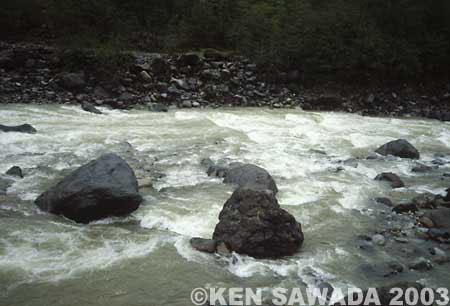
A rainy day at the lower reaches of Yarimi Bridge. It is difficult to keep fishing in such high water.
The other type requires logical thinking. If you get no logic you will not succeed how long you try. But if you get a certain logic you will unfasten soon or later. Then once you succeed you will easily remember how to do it even if you forget.
I have mentioned ring puzzles to say that fish are also divided into 2 types, as I have long believed. It is not clear whether fish are born into either type or their growing environment or living place divides them. Anyway, knowing the type makes it a little easier to catch a difficult fish.
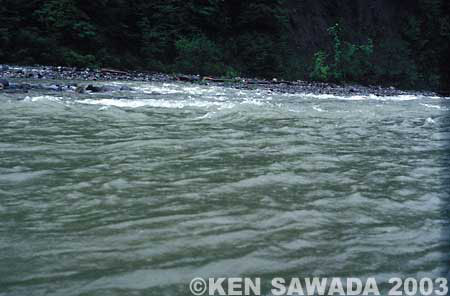
In front of Imadakan after rain. Anglers can do nothing but wait.
A Dream Yamame Trout of 40cm
In 1987 far more anglers came to fish the River Takahara. After April, when the opening month was over, fly fishermen clearly increased. Anglers from other areas, including me, are usually keen on fly fishing, while local anglers are good at Japanese traditional fly fishing.In those days I met several local fishermen every time I visited the River Takahara. It was quite natural because they came to the river every day, whether it rained or snowed. Within 2 months they came to know everything about the river, for example, how many yamame trout were staying in such and such a pool or a lot of char were staying in such and such a current.
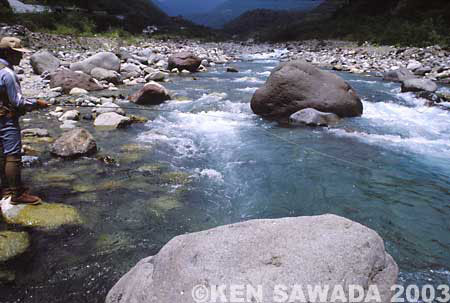
The lower reaches of Karukaya. Special points which seemed to have big fish appeared one after another.

This yamame trout defiantly made rises again and again during the day.
In the middle of May I got good news from one of those local fishermen. According to him, there was a big yamame trout in a pool of the upper reaches but none of them could catch it. It jumped defiantly in front of them in the evening. He saw it many times. Judging from its width of more than 10 cm, it must be over 40 cm long, so he said.
Usually it must be silly to jump at such a story. No angler reveals whereabouts of a trophy fish. In many cases the story is extremely exaggerated or totally made-up. Only an exception is the case that the angler can not continue fishing or gives up.
Although I had no intention to deny the story, I asked him why he decided to reveal such precious information. He said that the fish robbed his companions and him of the best fishing hours of a day for these several days. Realizing that farther challenge would make them waste the whole season, they gave up and he suggested that I should try, if I liked. I thanked him and promised to try.
The very spot was a deep pool at a little upper reaches of the Imadakan Inn, which lay upstream of the barrier of Kansaka. Its strong point was just large but nothing else. Karukaya lay at a little farther upper reaches, which was famous for its attractive scenery of countless big rocks. That was why anglers paid no attention to that flat area a little down Karukaya. Does a big fish really stay in that spot? I wondered but convinced myself that the big fish could stay here without being found by anglers who passed there in haste.

In the end of snow-melting season amago trout with extremely high bodies began to be caught.
In the evening I was standing at that pool a little earlier than fish’s rise time. A gentle current became suddenly wider and formed a large pool. There was a small tree at the opposite bank of the widening point, as the local fisherman had taught me. He said that the giant yamame trout made rises at the root of the tree.
Without that small tree I could have fished with my eyes closed. It was such an ordinary pool. I left there for a while. I wanted to see the pool to make sure how the stream was flowing at the rise spot. If the spot had been like a natural fortress, the fish would have luckily run into there. But the spot was just an ordinary simple stream, as I had imagined.
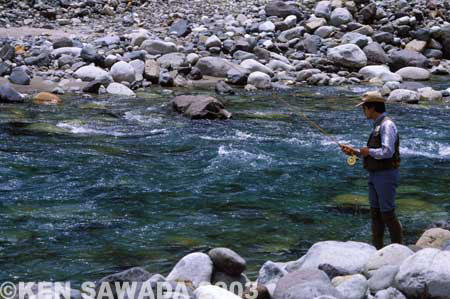
Karukaya area, spotted by big rocks, was popular among big-fish hunters.
An Odd Fish
If the fish makes rises there, it will be caught easily. Because it is easy to give the dry fly natural drift in that stream, the fish must be caught within a week. Furthermore, local anglers I knew were very good at making the dry fly drift in a drag-free way, using their long rod for traditional Japanese fly fishing. I wondered why they had given up.Many anglers had cast the fly. Probably some fly had drifted in a complete way of natural drift and some in a little incomplete way. Probably some had drifted perfectly. Why did the fish bit none of those flies?
Is that yamame trout too clever to be deceived? Due to so many bitter experiences, does it learn to avoid even natural drift of the fly?
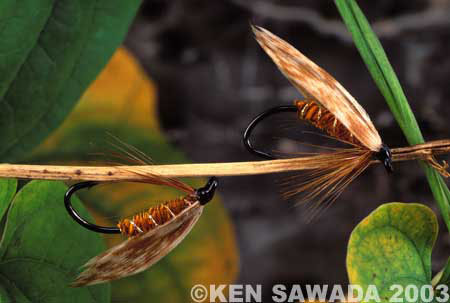
Cinnamon King keeps its good performance from morning till night.
Only one thing was sure, the fish was odd. I had no idea what made it so. But definitely it was not an ordinary fish. Probably it would be useless to cast the dry fly at fish’s rise hour, or even worse. If I cast the fly when it makes a rise, I might never catch it forever.
Thinking in this way, I fished upstream with the dry fly at the upper reaches of Karukaya area and came back at dusk, fishing downstream with the wet fly, as I had planned. When I returned to my destination pool, the windows of the Imadakan Inn looked still light. I did not know whether my fish had made rises during my absence. Anyway, its rise hour was over. It was already dark around the current but the surface of the pool spreading downstream was shining dimly.
I checked my leader and fly under the sky. Size 6 Peacock Queen was put to the tip of leader 2X, 7ft. 6 in. Size 6 Cinnamon King as a dropper was put to tippet 0X which was put to 70 cm away from the leader tip. Making sure that there was no trouble with the leader, I fished downstream from the middle of the current. But the current was so short that the fly started drifting under the twigs at the opposite bank at my 3rd casting. If the fish usually make rises around there it will move farther downstream now.

If the head and the tail were hidden the fish would be thought to be 40cm long.
I moved very carefully. When I stood just besides the twigs, the fly started drifting in the pool spreading like a pond. Although the stream hardly flowed at the border of the opposite bank where the fly settled, the line which settled on the current on this side guided the fly slowly to the pool. I kept the fly drifting calmly, feeling tense as if my whole body had been the rod tip.
Then the fly came to the spot where I thought the fish was staying now as far as it was finding the bait. Electricity ran down my rod tip. Immediately I set the hook I got a strong response with thud, unlike that of a yamame trout. The fish did not move but swung its head violently several times. Definitely it was a way how yamamme trout pulled the line.
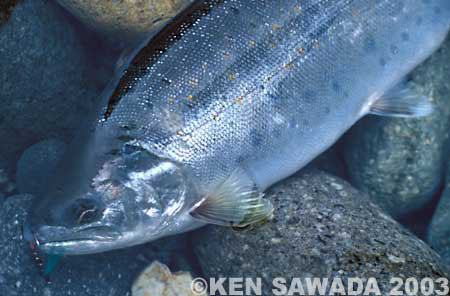
An amago trout bit Peacock-and-Green. The body is higher than yamame trout.
As the fish realized that it could not remove what stuck to its mouth, it swam upstream, passing my side. It moved upstream like crawling on the bottom at the heart of the stream and suddenly turned around to come downstream. Finally it stopped in the centre of the pool, which made me feel as if the hook had snagged on the bottom. I had to fight for more than 5 minutes to scoop it into the net. I could not see it well but its strong power assured me that it was big. I walked up on the bank for safety and put my hand into the net. How thick! It was so thick that I barely held it in my hand. But something is strange! I spread the net and shone it with a flash light. There was a yamame trout but it looked like a sea bream. It was 33cm long. Surely it looked to be 40cm long when its head and tail could not be seen.
This fish did not hesitate to swallow Peacock Queen, quite new to it. It was very careful of the dry fly or in the daytime but had a weakness for the wet fly after supper. Since then I have met the same type of fish again and again.
-- To be continued --
- NET SHOP INFORMATION

SL6 Black Spey Hooks
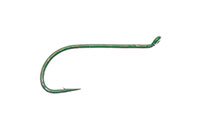
DU3 Limerick Spinner Hooks
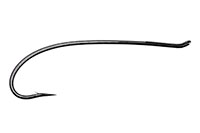
SL4 Single Bartleet Hooks
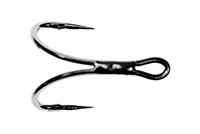
XD1 Tube Fly Double Hooks

DD2 Flat Perfect Hooks
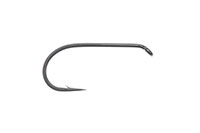
DD1 Black Terrestrial Hooks
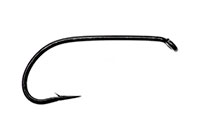
TD4 Old Limerick Wet Hooks

DU1 Silver May Hooks

MU1 Flat Midge Hooks

LD3 Long Limerick Hooks

TD2 Summer Sproat Hooks
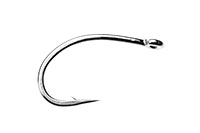
XS1 Tube Single Silver Hooks

TD6 Siver Sedge Hooks

SL5 Black Spey Hooks

DU3 Limerick Spinner Hooks
- TROPHY CLUB
- FLY SHOW
- EXHIBITION
- MASTERS`
- FLY DRESSING CONTEST Archives
- TRAVELLER Archives
- TACKLE IMPRESSIONS Archives
- ANGLERS` PHOTO GALLERY Archives
- ----------------------------------------------
- トロフィークラブ
- フライショー
- エキシビション
- マスターズ
- フライドレッシング・コンテスト・アーカイヴ
- トラヴェラー・アーカイヴ
- タックル・インプレッション・アーカイヴ
- アングラーズ・フォトギャラリー・アーカイヴ
株式会社サワダ 185-0021 東京都国分寺市南町3-13-4
SAWADA'S INC. 3-13-4 Minamicho, Kokubunji, Tokyo 185-0021, Japan
写真・ドキュメントの無断転載を禁じます。
All the images and documents found on this site are owned by Ken Sawada and may not be used without permission.
But, link to this site is FREE.
Copyright © 2000 - 2025 SAWADA'S INC.. All rights reserved.
SAWADA'S INC. 3-13-4 Minamicho, Kokubunji, Tokyo 185-0021, Japan
写真・ドキュメントの無断転載を禁じます。
All the images and documents found on this site are owned by Ken Sawada and may not be used without permission.
But, link to this site is FREE.
Copyright © 2000 - 2025 SAWADA'S INC.. All rights reserved.
